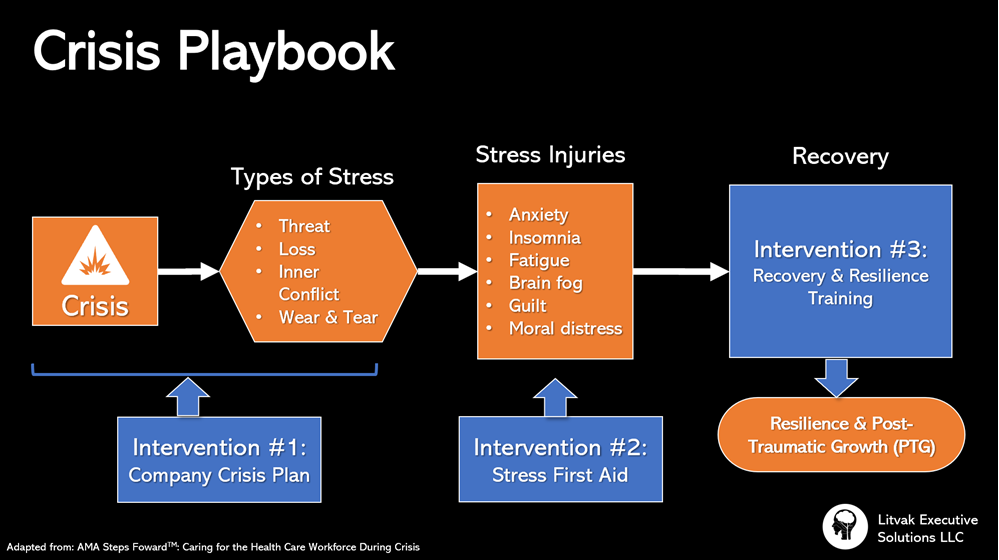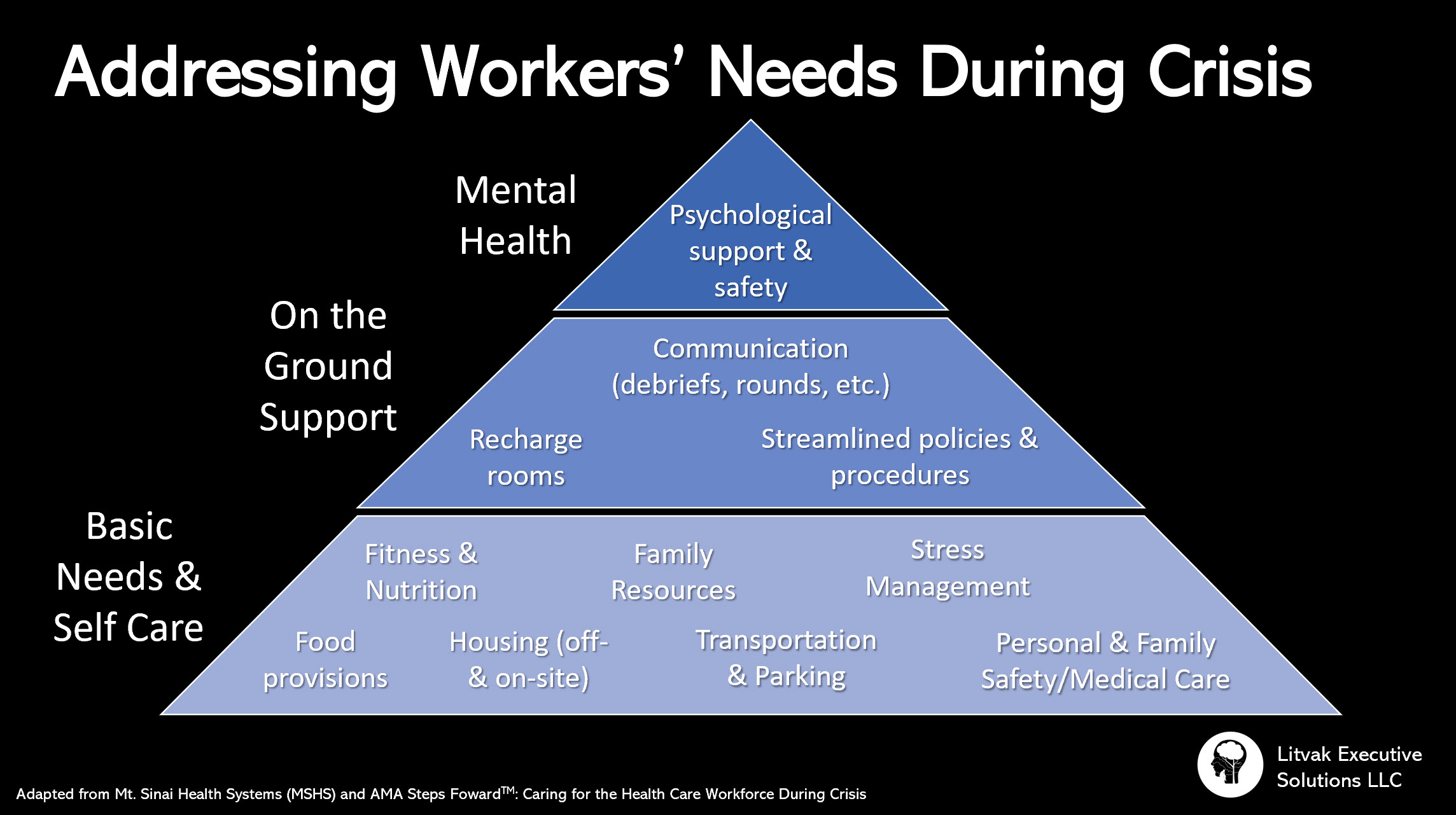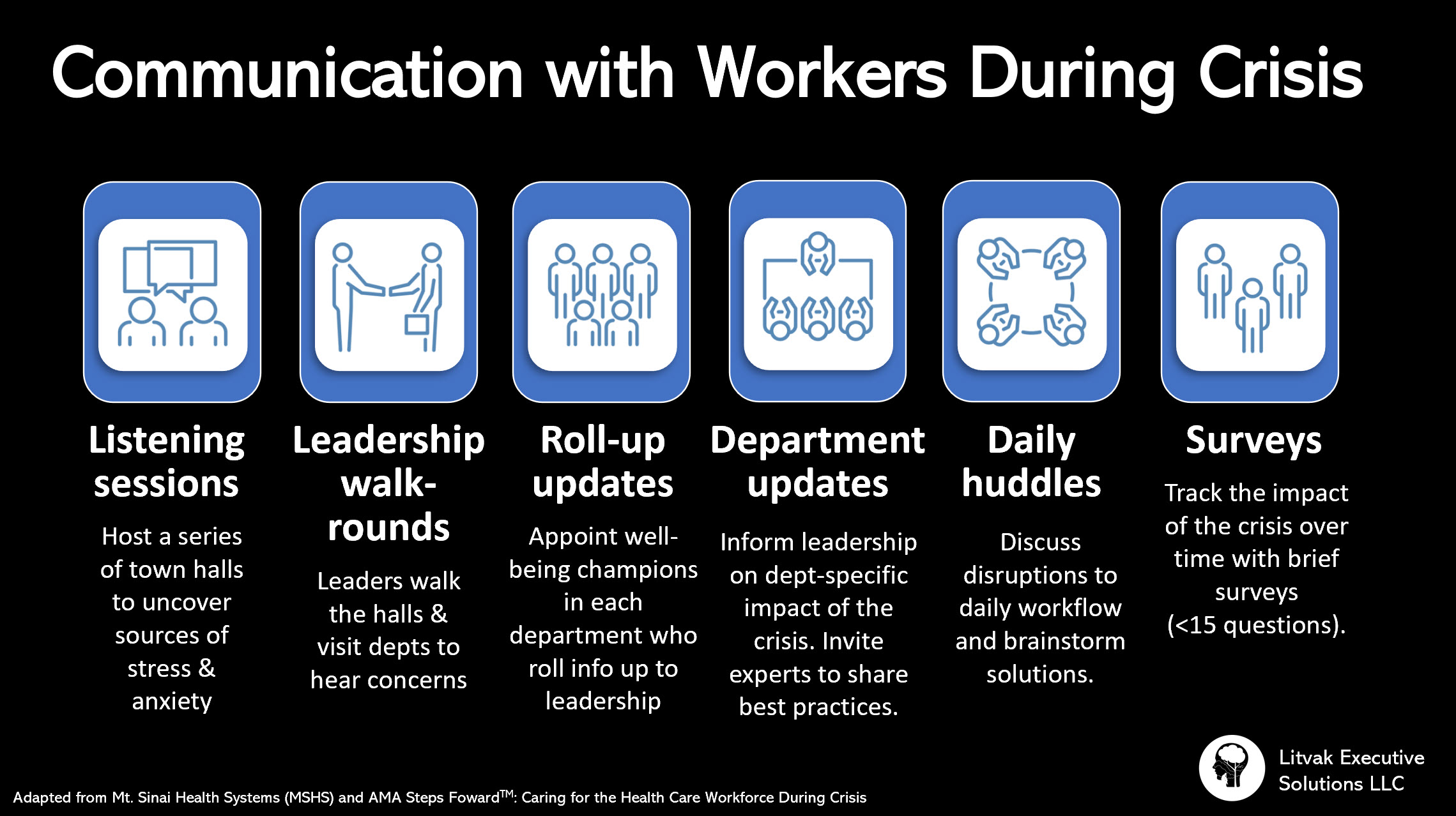In part 1 of this series, we looked at four types of stress that we face during a crisis.
Healthcare workers have been bravely battling these stressors on the front lines of the COVID-19 crisis. In response, the American Medical Association published a crisis playbook, Caring for the Health Care Workforce During Crisis, as part of AMA’s Steps Forward program.
While the details may vary, the same three-step crisis intervention plan can be applied across most industries:
Step #1: Develop a company crisis plan BEFORE the crisis. Appoint crisis management leaders and staff who will know when to take over and what to do when crisis hits. This proactive step will help curb the impact of the crisis and calm company employees.
Step #2: Apply “stress first aid” DURING the crisis. Assess the situation and provide crisis-specific support.
Step #3: Debrief AFTER the crisis. Update the crisis management plan and provide recovery and resilience training to help the company leadership and workers prepare for future crises.

Illustration by Pamela Coburn-Litvak
In this article, we’ll take a closer look at the first step: developing a company crisis plan.
Every Company Crisis Management Plan Should Include These Steps
Step 1: Appoint Crisis Management Leaders.
A crisis can send two separate shock waves through an organization. The first shakes up organizational production and workflow. This shock wave is easy to spot because it runs along the surface of an organization and disrupts its bottom line.
But the second wave spreads in the subterranean regions of an organization, making it harder to spot and harder to manage. This one is not about logistics – it’s about morale.
To put it bluntly, crises are scary. They can upset the organizational apple cart, throwing everything and everyone into a frenzy of panic and chaos.
Most organizations know this, so they have careful crisis management plans laid out to manage the first wave of organizational upset. Fewer take the extra time needed to plan for the second wave.
Appointing a Chief Wellness Officer to the organizational C-suite can be an important step in planning for both. A recent Forbes article points out that while CWOs are still uncommon outside the healthcare industry, the need to protect the mental health of workers in all industries has never been more important.
The AMA recommends that the CWO appoint a crisis task force charged with identifying and serving the workers’ basic needs: food, shelter, transportation, and safety. During times of crisis, the CWO can also take the lead in alleviating the aftershocks of stress in terms of ongoing threat, trauma, loss, inner conflict, and psychological wear and tear.
Step 2: Create a Crisis Management Plan to Meet Workers’ Needs
To survive crisis conditions, companies need to know two things: what they need to stop doing and what they need to start doing. This involves identifying non-essential tasks that can be suspended during crisis as well as the emergency functions to kick into gear.
Both lists will of course be crisis-specific and industry-specific.
What needs to stop
In healthcare, the Centers for Medicare and Medicaid Services (CMS) have temporarily modified several policies in order to give frontline healthcare workers more mental and emotional bandwidth to care for their patients.
For example, doctors can now verbally communicate some life-saving medical orders to nurses and other healthcare staff, like giving blood transfusions for their patients, instead of having to write the order down somewhere first. The CMS also temporarily waived credentialing requirements that would prevent doctors whose privileges were about to expire from continuing to practice. This has allowed doctors and nurses to travel and serve communities hardest hit by COVID-19.
When hit by crisis, such streamlining is necessary in every industry. Pre-planning where and what to streamline is an essential part of a crisis management plan.
What needs to start
Again, this will be crisis- and industry-specific. In healthcare, the AMA urges crisis management leaders to coordinate with Hospital Incident Command System (HICS) to make sure the basics are covered: logistics, communication, psychosocial needs, and mental health support.
How do we support the workers’ needs?
The Well-Being staff at the Mt. Sinai health system hospitals in New York have outlined a basic hierarchy of needs for healthcare workers during the COVID-19 crisis. This includes meeting their basic needs, providing on-the-ground support to frontline medical staff, and providing mental and psychosocial support – the last being sadly neglected in many crisis management plans.

Illustration by Pamela Coburn-Litvak
-
Basic Needs & Self Care
-
On the Ground Support
-
Mental Health
Food & Provisions
During COVID-19, companies have provided workers with:
- free food stations in lounge and break areas;
- low-cost and/or free meal options in partnership with local restaurants;
- DashPasses through DoorDash.com;
- nutritional counseling, recipes, and meal preparation tips; and
- grocery runs
Housing
During COVID-19, healthcare systems have provided workers with free or lost-cost temporary housing near the hospital.
Transportation & Parking
During COVID-19, healthcare systems have provided workers with:
- parking cost waivers;
- Uber or Lyft transport assistance for sleep-deprived clinicians;
- Rideshare carpool programs; and
- expanded shuttle services
Personal & Family Safety
During COVID-19, healthcare systems have provided workers with:
- personal protective equipment (PPE);
- on-site showers and laundry service;
- guidelines to prevent bringing infectious material home; and
- lists of COVID testing sites
Family Resources
During COVID-19, healthcare systems have provided workers with:
- on-site, low-cost childcare or childcare referral services;
- workshops on distance learning for parents;
- academic support and extracurricular enrichment (via corporate partnerships); and
- eldercare services
Fitness & Nutrition
During COVID-19, healthcare systems have provided workers with:
- free nutritional counseling;
- special care for those with diabetes;
- calendar of well-being events;
- recreation discounts;
- fitness apps; and
- online recipes and fitness resources
Stress Management
During COVID-19, healthcare systems have provided workers with:
- calendar of well-being events;
- one-on-one self-care consultations;
- virtual classes on music therapy, yoga, etc.
Mental Health Rounding Teams
Mount Sinai Health Systems (MSHS) provides on-site mental health support for their clinical staff. These rounding teams do regular check-ins with clinicians and provide resources as needed.
Recharge Rooms
Mount Sinai Health Systems (MSHS) partnered with Studio Elsewhere and the Abilities Research Center to create “recharge rooms” across their hospital network. The rooms are described in detail in this podcast.
Peer Support
Consider starting groups that provide:
- crisis support
- grief support
- resiliency training
- spiritual practices & mindfulness
- parent support
- caregiver support
- social gatherings
Crisis Suppport
Make sure workers know of internal and external resources (e.g. hotlines, psychiatric emergency services, sexual assualt and prevention programs, and suicide prevention services.
Psychological Safety
Workers need to feel safe in expressing their concerns at the workplace. Assure them that there will not be professional consequences (e.g. reprimand, job demotion, or job loss) for speaking up about potential concerns and fears.
Step 3: Develop Mechanisms to Monitor Stress, Burnout, and Ongoing Needs
It’s vital that company leaders understand the stresses and needs of workers during a crisis, which may develop and change over time.
Communication is key here, and for two reasons. First, lack of communication creates an information vacuum. Problem is, this vacuum does not stay empty very long – it attracts all sorts of misinformation and the anxiety and confusion that come with it. And on the flip side, communication can empower workers about what they can do to help themselves.
In healthcare, the AMA advocates several communication strategies:

Illustration by Pamela Coburn-Litvak
Conclusion
Drs. Albert Wu, Cheryl Connors, and George Everly all work at Johns Hopkins Center for Health Services and Outcomes Research. In their recent article for the Annals of Internal Medicine, they recommended three strategies to help healthcare institutions grappling with the COVID-19 crisis. The same strategies can be implemented across industries: 1) provide strong leadership focused on resilience, 2) communicate with and empower workers, and 3) provide support at all levels of the organization that anticipates and meets workers’ needs.
As outlined above, a well-thought crisis management plan will encompass all three of these strategies.

